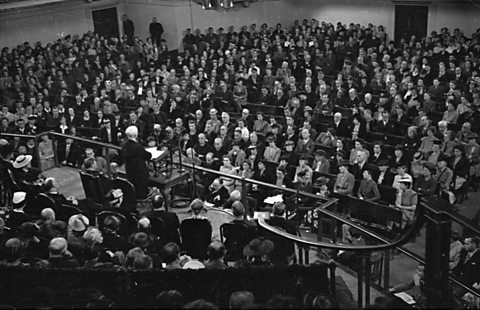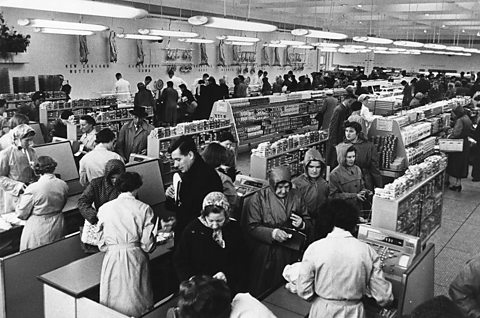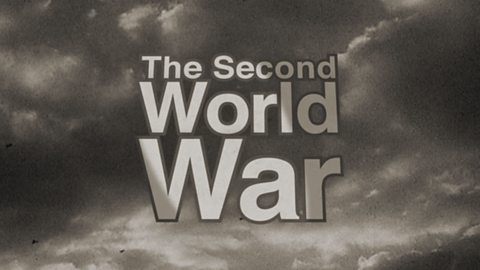The early years
Britain needed rebuilding following the Second World War (1939-1945) and its returning soldiers needed jobs and medical care. Although Britain had won the war, it led to major short-term economic issues, as many ships that transported goods had been sunk.
Additionally, many countries who were part of the British Empire wanted to leave. The British Empire was a collection of countries or territories ruled by Britain. By 1913, Britain ruled 23 per cent of the entire world’s population.
Countries began to question Britain’s right to rule them after the Second World War. India gained independence in 1947 after non-violent protests led by Mahatma Gandhi.
Britain also found that managing an empire was costly for the army and navy. This impacted the British economy because the countries that were a part of the empire were an important part of trade. Britain also had to start repaying its war debts despite seeing a drop in trade.
The Beveridge Report

After winning the 1945 election, Prime Minister Clement Attlee formed a plan in response to the Beveridge Report published in 1942. The report described the social issues that needed special attention after the war. William Beveridge who was given the task of writing the report came to the conclusion that Britain‚Äôs social issues were caused by ‚ÄėFive giants‚Äô which were:
- want ‚Äď people were poor
- disease ‚Äď healthcare was inadequate
- ignorance ‚Äď the population was not well-educated
- squalor ‚Äď houses were in very poor condition
- idleness ‚Äď lack of jobs and opportunities to earn a wage
Welfare state
Beveridge proposed the creation of a ‚Äėcradle to grave‚Äô social system which formed the basis of his plan to establish a welfare stateType of government where the state takes care of its citizens‚Äô economic and social well-being. . Attlee implemented many of Beveridge‚Äôs ideas such as free medical care for all and free education for all children up to 15 years old. Also, a huge scheme to build thousands of high quality council houses was introduced to deal with the issue of squalor. In order to try to tackle poverty, a social security scheme was introduced offering pensions for the elderly and benefitsMoney to support people eg due to unemployment, illness or disability. for sick and disabled people.
Nationalisation
One of Attlee’s government’s decisions was to nationalisationIndustries or companies owned and controlled by the state. some industries. This is when the government takes control or ownership of companies or industries. In the 1940s, the coal, electricity, rail, iron and steel industries were put in state ownership. This ensured that people’s jobs in crucial fields were secure in the effort to rebuild the country. Following the Second World War, the government took ownership and control of 1,200 coal pits owned by 800 companies and who employed 700,000 people.
The long term
Fifteen years after the war, there was a period of economic success in Britain. The 1950s were considered a ‚ÄėGolden Age‚Äô as the number of people out of work was low and workers‚Äô wages were increasing.
The Golden Age of the 1950s
Wages, including those of working class people, increased during the post-war period. Between 1955 and 1969, wages increased by 130 per cent. In 1957, teenagers were earning 50 per cent more pay compared to 1938. Families therefore had money to spend on things like holidays. Butlins opened a holiday camp in Pwllheli in 1950.
Shopping
People‚Äôs shopping habits today have been shaped by the period following the Second World War. In this period shopping centres and ‚Äėchain‚Äô shops were opened for the first time in cities as a result of people‚Äôs new wealth.
‚ÄėSelf-service‚Äô shops, supermarkets where the customer would get their own goods, also opened for the first time. The Co-op opened the first self-service shop in London in 1948, and Tesco later followed in St Albans.
Mass production sparked a growth in car sales as more people could afford them. This influenced the distance people were willing to travel which led to a major road building scheme. The first stretch of motorway in Britain opened in 1958 and the Severn Bridge between England and Wales opened in 1966.

Consumer goods
Before the war, only the wealthiest people could afford to buy machines for their homes. As wages increased, people had more money to spend on goods for their homes. As sales were higher, prices fell which meant more people could afford to buy them. The influence of neighbours was also important - families wanted to copy each other and buy the latest equipment. This meant that electricity had to be available in all new houses and by 1960 electrificationThe process of changing a system or machine to use electrical power. had reached the most rural areas.
In 1955, only 20 per cent of people owned a car in Britain, but this was about to change. More and more people owned consumer goods, eg a television, vacuum cleaner, music player and washing machine. By 1960, 40 per cent of homes owned a washing machine and 21 per cent owned a fridge.
The use of fridges and freezers led to changes in people’s diets, and frozen foods were now sold in shops. One negative impact of the growth in TV sales in the 1950s and 1960s was that fewer people went to the cinema.
Advertising
Advertising had an important role in drawing attention to the new goods. The advertisements tried to stress that many of these goods would transform families’ lives.
In 1960, companies spent four times as much on advertisements compared to 1947. Which magazine was launched in 1957 offering advice on goods and services, and sold 300,000 copies.
Hire-purchase
The hire-purchasePayment for goods over a period of time - a form of credit. system was introduced so that people could afford to buy consumer goods. This system meant that people could pay for household goods over a long period, ensuring that more people could afford to buy them. By 1956, half of TV sales were made using this system and this then led to the credit card system.
Video - The post-war economy
The 1960s and 70s, the ‚Äėflower power‚Äô decades. It was time for people to start having fun and enjoying life again after the war.
People were definitely starting to spend more money, buying things like radios, televisions and vacuum cleaners. Not what I’d spend money on, but each to their own.
Back in the day these would have been invaluable, but not everyone could afford them. Families were financially affected by the Second World War and it took them a long time to save and rebuild their possessions.
Let‚Äôs rewind. It‚Äôs 1945, 8 May to be precise and the Second World War in Europe has ended. This date has been known as VE DAY ‚Äď Victory in Europe Day ‚Äď ever since.
Fantastic, but it’s a while before Wales, the UK and the rest of the world get back on their feet, but good things are around the corner.
If we fast forward, things are starting to boom again. Money seems to be rolling in - not that it grows on trees, mind you, but people are able to buy things.
By 1953, thousands of Welsh people had bought a television. The picture was black and white of course.
Some people could afford an electric kettle, an electric iron and a vacuum cleaner too by 1960.
People were buying colour TVs by 1971. It was out with the old and in with the new. Things were on the up, people were buying loads more things which meant more people were needed to make them.
Enter modern consumerism! But who supplied the materials for these things?
Well, Wales helped out a lot, supplying England and the rest of the world with steel.
Our natural world is influenced by the choices we make. The mass production of materials such as metal and plastic meant that we could achieve amazing things like go to the Moon.
But it also created a load of problems.
Our world today cannot cope with the current rate of consumption. Have people forgotten the difference between ‚Äėwant‚Äô and ‚Äėneed‚Äô?
Is there an easy solution to all of this?
Impact on Welsh industries
The growth in the sale of cars and consumer goods impacted traditional industries in Wales such as the steel industry. As more people bought cars and machines made of metal, this had a positive impact on steelworks in Wales.
However, this was temporary because in this period, traditional Welsh industries such as steel, coal and slate started to face problems. By the 1960s, the demand for the products of these traditional industries had fallen following growth at the end of the war. Therefore, fewer workers were needed as less coal, steel and slate were being sold.
After flourishing in the 1950s, 50 coal mines closed in Wales between 1957 and 1964. By 1970 fewer than 1,000 worked in the north Wales slate quarries. 6,500 steelworkers lost their jobs at the Shotton steelworks in Flintshire in 1980.
Did people’s lives improve after the Second World War?
On the one hand, many people saw an improvement in the 1950s as unemployment was low and food rationing ended. For many it was a period of wealth as they had spare cash to spend on goods.
However, not everyone became richer after the war, as many were still unemployed and unable to live on benefits. Pensioners had less money to spend as the value of their pension had dropped. Also, by the late 1950s, workers in traditional jobs such as coal, iron, steel and slate were losing their jobs as works shut down.
Quiz - The post-war economy
More on Conflict and peace
Find out more by working through a topic
- count1 of 4

- count2 of 4

- count3 of 4
